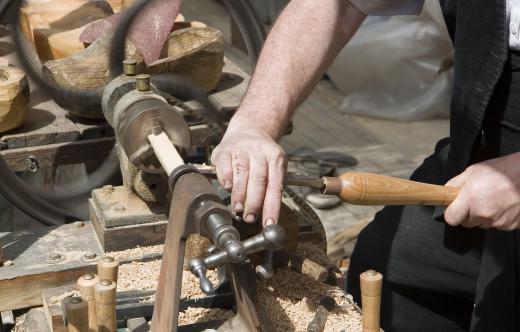A lathe spindle is the “business end” of a lathe. Lathes are used to cut, shape and machine wood or metal, and come in a wide variety of configurations and sizes. The spindle is usually located on the left end of the lathe bed as looked at from the operator’s viewpoint.
The spindle’s entire purpose is to hold and rotate the material to be worked without allowing undue vibration or flutter during the machining process. The bits, or cutting tools, may be integrated into the lathe, fitted as an accessory or hand-held. The lathe spindle is, consequently, the part of the machine that makes it a lathe.

The lathe spindle ordinarily consists of a plate or disc either mounted to a shaft or with an integrated shaft, and incorporating a chuck configured to grasp the particular stock to be turned. The stock to be worked using the lathe is placed end to end, usually horizontally, above the lathe bed, with one end inserted into the spindle chuck and the other into the freewheeling tailstock located at the opposite end of the bed from the spindle.
The spindle and tailstock are maneuvered toward each other thus jamming the stock. The lathe is started and the spindle begins to rapidly rotate. Next, the cutting bits are engaged with the stock and the turning of the material is accomplished through the stationary bits cutting and shaping the material that is being held and spun by the spindle.
In all modern lathes, the lathe spindle axle, with its attendant gearing, bearings, adjusting screws, and, in many cases, its motor, is contained in the headstock. Essentially, the headstock is a housing that protects the enclosed machinery from contamination and damage. The headstock housing also protects the operator from injury due to improper operation or a malfunction of the machine.
Metal lathes, those that are used to precisely machine metal stock in high volume operations, are large machines and will, by necessity, have sizable, heavy-duty spindles that are turned by electric motors. Such heavyweight spindles are better able to withstand the hefty stresses and strains consistent with machining metal stack. Metal-working lathes are available for the home or small shop as well, but only used for very low-volume, light-duty applications, since the spindles and bearings which take the brunt of the stress in the machining process are considerably downsized.
A woodworking lathe and its lathe spindle need not be so large or sturdy, thus, except for high-volume production machines, such smaller lathes are generally suitable for a home workshop.
